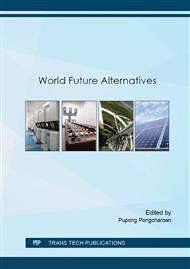p.14
p.23
p.29
p.34
p.39
p.44
p.49
p.54
p.59
Development of Photocatalytic Conversion of Glucose to Value-Added Chemicals by Supported-TiO2 Photocatalysts
Abstract:
Biomass is an important renewable energy resource, which is used to replace the petroleum to produce chemicals. Glucose is a monomer of cellulose, which is the main component of biomass. In this work, conversions of glucose to value-added chemical by a simple method have been reported. TiO2 photocatalysts were fabricated by sol-microwave method. Value-added chemical production was successfully carried out via photocatalytic conversion of glucose with TiO2 photocatalysts. Arabinose, xylitol, gluconic acid, and formic acid were produced with photocatalytic reaction of TiO2 under UVA irradiation. The value-added products (gluconic acid, arabinose, and xylitol) can generally be further used as building blocks for biorefinery production, pharmaceutical production, and food industry. In the conventional sol-microwave method, the agglomeration of fabricated TiO2 particle was a limitation of photocatalytic activity. Therefore, the modification of TiO2 fabrication by use of zeolite as a TiO2 support was applied to increase efficiency of photocatalytic conversion of glucose and its selectivity. The effect of TiO2 dosage on zeolite (TiO2/zeolite) on photocatalytic activity and yield of products was monitored. The results from scanning electron microscopy (SEM) images indicated that zeolite supporter reduced agglomeration of spherical TiO2 particles. The well distribution of TiO2 particles on surface of zeolite particles could be observed in 15%TiO2/zeolite. It was found that the highest photocatalytic conversion of glucose (77.3%) was obtained from the use of 15%TiO2/zeolite as photocatalyst. The yields of gluconic acid, arabinose, xylitol, and formic acid were 8.6, 26.0, 3.7, and 33.89%, respectively.
Info:
Periodical:
Pages:
39-43
Citation:
Online since:
June 2016
Keywords:
Price:
Сopyright:
© 2016 Trans Tech Publications Ltd. All Rights Reserved
Share:
Citation:


